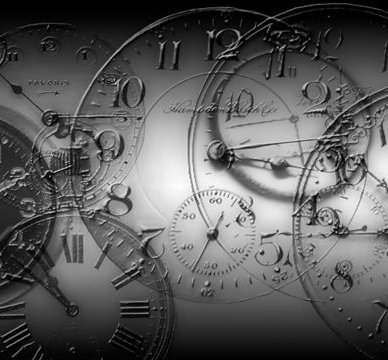THE FIRST ONE-HUNDREDTH SECOND BY STEVEN WEINBERG 2

THE FIRST ONE-HUNDREDTH SECOND BY STEVEN WEINBERG PART TWO
These rather intuitive ideas have recently been put on a much firmer mathematical foundation. In 1973 it was shown by three young theorists, Hugh David Politzer of Harvard and David Gross and Frank Wilczek of Princeton, that, in a special class of quantum field theories, the forces between quarks do actually become weaker as the quarks are pushed closer together. (This class of theories is known as the "non-Abelian gauge theories" for reasons too technical to explain here.) These theories have the remarkable property of "asymptotic freedom": at asymptotically short distances or high energies, the quarks behave as free particles. It has even been shown by J. C. Collins and M. J. Perry at the University of Cambridge, that in any asymptotically free theory, the properties of a medium at sufficiently high temperature and density are essentially the same as if the medium consisted purely of free particles. The asymptotic freedom of these non-Abelian gauge theories thus provides a solid mathematical justification for the very simple picture of the first hundredth of a second—that the universe was made up of free elementary particles.
The quark model works very well in a wide variety of applications. Protons and neutrons really do behave as if they consist of three quarks, rho mesons behave as if they consist of a quark and an antiquark, and so on. But despite this success, the quark model presents us with a great puzzle: even with the highest energies available from existing accelerators, it has so far proved impossible to break up any hadron into its constituent quarks.
The same inability to isolate free quarks also appears in cosmology. If hadrons really broke up into free quarks under the conditions of high temperature that prevailed in the early universe, then one might expect some free quarks to be left over at the present time. The Soviet astrophysicist Ya. B. Zeldovich has estimated that free leftover quarks should be roughly as common in the present universe as gold atoms. Needless to say, gold is not abundant, but an ounce of gold is a good deal easier to purchase than an ounce of quarks.
The puzzle of the nonexistence of isolated free quarks is one of the most important problems facing theoretical physics at the present moment. It has been suggested by Gross and Wilczek and by myself that "asymptotic freedom" provides a possible explanation. If the strength of the interaction between two quarks decreases as they are pushed close together, it also increases as they are pulled farther apart. The energy required to pull a quark away from the other quarks in an ordinary hadron therefore increases with increasing distance, and it seems eventually to become great enough to create new quark-antiquark pairs out of the vacuum. In the end, one winds up not with several free quarks, but with several ordinary hadrons. It is exactly like trying to isolate one end of a piece of string: if you pull very hard, the string will break, but the final result is two pieces of string, each with two ends! Quarks were close enough together in the early universe so that they did not feel these forces, and could behave like free particles. However, every free quark present in the very early universe must, as the universe expanded and cooled, have either annihilated with an antiquark or else found a resting place inside a proton or neutron.
So much for the strong interactions. There are further problems in store for us as we turn the clock back toward the very beginning.
One truly fascinating consequence of modern theories of elementary particles is that the universe may have suffered a phase transition, like the freezing of water when it falls below 273° K (=0°C). This phase transition is associated not with the strong interactions, but with the other class of short-range interaction in particle physics, the weak interactions.
The weak interactions are those responsible for certain radioactive decay processes like the decay of a free neutron or, more generally, for any reaction involving a neutrino. As their name indicates, the weak interactions are much weaker than the electromagnetic or strong interactions. For instance, in a collision between a neutrino and an electron at an energy of one million electron volts, the weak force is about one ten-millionth (10^-7) of the electromagnetic force between two electrons colliding at the same energy.
Despite the weakness of the weak interactions, it has long been thought that there might be a deep relation between the weak and electromagnetic forces. A field theory which unifies these two forces was proposed in 1967 by myself, and independently in 1968 by Abdus Salam. This theory predicted a
new class of weak interactions, the so-called neutral currents, whose existence was confirmed experimentally in 1973. It received further support from the discovery, starting in 1974, of a whole family of new hadrons. The key idea of this kind of theory is that nature has a very high degree of symmetry, which relates the various particles and forces, but which is obscured in ordinary physical phenomena. The field theories used since 1973 to describe the strong interactions are of the same mathematical type (non-Abelian gauge theories), and many physicists now believe that gauge theories may provide a unified basis for understanding all the forces of nature: weak, electromagnetic, strong, and perhaps gravitational forces. This view is supported by a property of the unified gauge theories that had been conjectured by Salam and myself, and was proved in 1971 by Gerard 't Hooft and Benjamin Lee: the contribution of complicated Feynman diagrams, though apparently infinite, gives finite results for the rates of all physical processes.
For studies of the early universe, the important point about the gauge theories is that, as pointed out in 1972 by D. A. Kirzhnits and A. D. Linde of the Lebedev Physical Institute in Moscow, these theories exhibit a phase transition, a kind of freezing, at a "critical temperature" of about 3,000 million million degrees (3 X lO^15 ° K). At temperatures below the critical temperature, the universe was as it is now: weakinteractions were weak, and of short range. At temperatures above the critical temperature, the essential unity between the weak and electromagnetic interactions was manifest: the weak interactions obeyed the same sort of inverse-square law as the electromagnetic interactions, and had about the same strength.
The analogy with a freezing glass of water is instructive here. Above the freezing point, liquid water exhibits a high degree of homogeneity: the probability of finding a water molecule at one point inside the glass is just the same as at any other point. However, when the water freezes this symmetry
among different points in space is partly lost: the ice forms a crystal lattice, with water molecules occupying certain regularly spaced positions, and with almost zero probability of finding water molecules anywhere else. In the same way, when the universe "froze" as the temperature fell below 3,000 million million degrees, a symmetry was lost—not its spatial homogeneity, as in our glass of ice, but the symmetry between the weak and the electromagnetic interactions.
It may be possible to carry the analogy even farther. As everyone knows, when water freezes it does not usually form a perfect crystal of ice, but something much more complicated:a great mess of crystal domains, separated by various types of crystal irregularities. Did the universe also freeze into domains? Do we live in one such domain, in which the symmetry between the weak and electromagnetic interactions has been broken in a particular way, and will we eventually discover other domains?
 THE FIRST ONE-HUNDREDTH SECOND BY STEVEN WEINBERG 3
THE FIRST ONE-HUNDREDTH SECOND BY STEVEN WEINBERG 3

Kindness is a mark of faith, and whoever has not kindness has not faith.
--- Prophet Muhammad Peace be Upon Him





